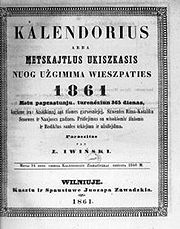
Laurynas Ivinskis
Encyclopedia

Lithuania
Lithuania , officially the Republic of Lithuania is a country in Northern Europe, the biggest of the three Baltic states. It is situated along the southeastern shore of the Baltic Sea, whereby to the west lie Sweden and Denmark...
n teacher, publisher, translator and lexicographer, from a Samogitian noble family. He is notable for a series of annual calendar
Calendar
A calendar is a system of organizing days for social, religious, commercial, or administrative purposes. This is done by giving names to periods of time, typically days, weeks, months, and years. The name given to each day is known as a date. Periods in a calendar are usually, though not...
s published between 1847 and 1877, in which he summarized the daily life of Samogitia
Samogitia
Samogitia is one of the five ethnographic regions of Lithuania. It is located in northwestern Lithuania. Its largest city is Šiauliai/Šiaulē. The region has a long and distinct cultural history, reflected in the existence of the Samogitian dialect...
n peasantry, Laurynas Ivinski also published literary works by some of the most renown local authors. Laurynas Ivinskis was the first to publish the most famous Antanas Baranauskas
Antanas Baranauskas
Antanas Baranauskas was a Lithuanian poet, mathematician and a catholic bishop of Polish town Sejny. Baranauskas is best known as the author of the Lithuanian language poem Anykščių šilelis. He used various pseudonyms, including A.B., Bangputys, Jurksztas Smalaūsis, Jurkštas Smalaūsis, and Baronas...
' work Anyksčių Šilelis.
Biography

Kaunas
Kaunas is the second-largest city in Lithuania and has historically been a leading centre of Lithuanian economic, academic, and cultural life. Kaunas was the biggest city and the center of a powiat in Trakai Voivodeship of the Grand Duchy of Lithuania since 1413. During Russian Empire occupation...
city teacher's certificate. He prepared the first Lithuanian calendar back in 1845, however due to lack of funds the calendar was not printed in Vilnius
Vilnius
Vilnius is the capital of Lithuania, and its largest city, with a population of 560,190 as of 2010. It is the seat of the Vilnius city municipality and of the Vilnius district municipality. It is also the capital of Vilnius County...
until a year later. His calendar Metu skajtlus ukiszkas ant metu Wieszpaties circulated until Lithuanian press ban
Lithuanian press ban
The Lithuanian press ban was a ban on all Lithuanian language publications printed in the Latin alphabet within the Russian Empire, which controlled Lithuania at the time. Lithuanian-language publications that used the Cyrillic alphabet were allowed and even encouraged...
in 1864. The calendars were a form of an almanach
Almanach
Almanach is an album by Malicorne. As before, it has a complex sound. The arrival of Hughes de Courson has given the album a more classical feel.- Track listing :# "Salut à la compagnie" – 0:55# "Quand j'étais chez mon père" – 3:44...
, informing the readers of incoming fair
Fair
A fair or fayre is a gathering of people to display or trade produce or other goods, to parade or display animals and often to enjoy associated carnival or funfair entertainment. It is normally of the essence of a fair that it is temporary; some last only an afternoon while others may ten weeks. ...
s and festivities, but also of basic news on medicine, veterinary, agriculture and housekeeping. From 1852 they also included a literary section. Out of 22 Lithuanian language
Lithuanian language
Lithuanian is the official state language of Lithuania and is recognized as one of the official languages of the European Union. There are about 2.96 million native Lithuanian speakers in Lithuania and about 170,000 abroad. Lithuanian is a Baltic language, closely related to Latvian, although they...
calendars published between 1847 and 1864, and then again in 1877, three were in the Cyrillic alphabet
Cyrillic alphabet
The Cyrillic script or azbuka is an alphabetic writing system developed in the First Bulgarian Empire during the 10th century AD at the Preslav Literary School...
, while the remaining 19 were in Latin alphabet
Latin alphabet
The Latin alphabet, also called the Roman alphabet, is the most recognized alphabet used in the world today. It evolved from a western variety of the Greek alphabet called the Cumaean alphabet, which was adopted and modified by the Etruscans who ruled early Rome...
, used by most for the Lithuanian language. As publishing books and newspapers in Lithuanian was banned by the tsarist authorities, Ivinskis' calendars served the role of press
Printer (publisher)
In publishing, printers are both companies providing printing services and individuals who directly operate printing presses. With the invention of the moveable type printing press by Johannes Gutenberg around 1450, printing—and printers—proliferated throughout Europe.Today, printers are found...
for a large number of Lithuanian speakers. During the ban Ivinskis lectured in secret Lithuanian school, established in Lubiai.
Ivinskis settled in Rietavas
Rietavas
Rietavas is a city in Lithuania on the Jūra River. According to the 2001 census it had a population of 3,979. It is the capital of Rietavas municipality.The city is famous for building the first power station to produce electricity in Lithuania in 1892...
and lived there between 1874 and 1878. During this period he wrote a book Pasauga, which is considered as one of the first Lithuanian books dedicated to environment protection theme. Apart from publishing his calendars, Ivinskis was also an active translator from German and English. He also started working on a Polish-Lithuanian and Russian-Lithuanian dictionaries, as well as numerous works in Polish language
Polish language
Polish is a language of the Lechitic subgroup of West Slavic languages, used throughout Poland and by Polish minorities in other countries...
. Ivinskis died on August 29, 1881, and was buried in Kuršėnai
Kuršenai
Kuršėnai is the twenty-fifth largest city in Lithuania. According to the 2001 census, it had 14,197 residents.-Famous people:* Stasys Raštikis, Lithuanian army general* Donald Kagan, Yale Classics professor-References:...
.

